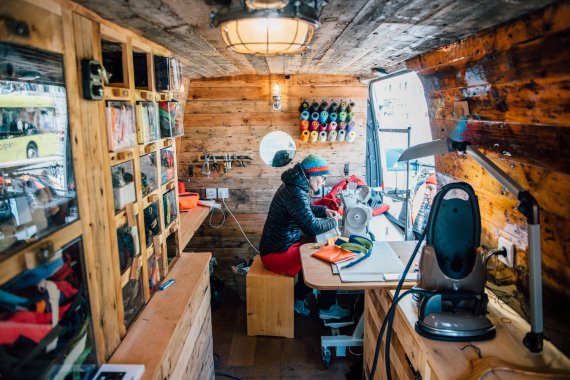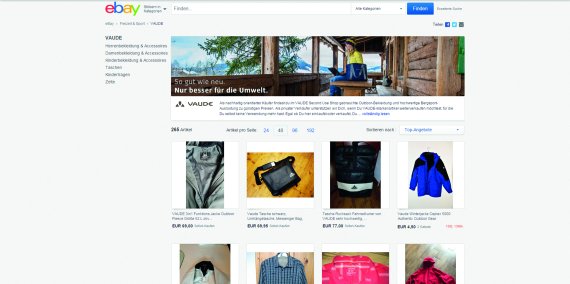
Until now, the industry has located the greatest environmental effect in the production of
clothing. It is now known that use and disposal also have an impact on the environment.
environment. The logic is simple: if a garment is worn for longer, less is produced and less is
less is produced and less is thrown away. If, thanks to repairs and upcycling, you use your clothes for just
nine months longer thanks to repairs and upcycling, you reduce your ecological footprint by 20 to
30 percent, according to a paper by WRAP. The nonprofit organization
is developing strategies to accelerate the shift to a sustainable industry.
"In our sustainability strategy, product longevity is one of the most important things," explains Åsa Andresson, Sustainability and Quality Manager at Peak Performance. To ensure this, the company has defined processes for the entire supply chain and selects suppliers and production partners very carefully. The concept is based on cooperation with the Sustainable Apparel Coalition (SAC). This developed the popular Higg Index, which offers standardized measures for a more sustainable value chain.
"Life-extending measures" are also incorporated into the design of the garments. The products should be easy to repair so that nothing stands in the way of upcycling clothing. Parts that wear out easily, such as zippers, cords and snaps, are available as replacement parts. Many companies offer a repair service - some even promote this:
- Vaude developed repair instructions together with the online platform ifixit, encouraging consumers to do-it-yourself.
- Patagonia is touring European ski resorts in a bus as part of its Worn Wear Tour. Consumers can have wear defects and damage repaired on site for free. Additional workshops explain the sustainable use of functional clothing.
The promotion of second-life strategies is showing success. In an interview in the Süddeutsche Zeitung, Melody Harris-Jensbach, the CEO of Jack Wolfskin, was asked why her brand did not focus on environmental issues such as repairing clothing. Her answer: "We've also had a repair service for over 20 years. But we never made a big deal about it and made a marketing campaign out of it. That was certainly a mistake."
For many people under 30, ownership is no longer anything but a form of consumption. Depending on function and occasion, clothing is shared, exchanged and rented. The industry's Second Life initiatives tie in with this attitude.
Second Life stands for measures that give products a second life. Companies offer their customers the upcycling of their clothing if it shows heavy signs of use. Depending on their condition, these are recycled, resold or donated to charitable organizations.
For example, the sporting goods retailer Decathlon has also been offering an online platform for the resale of sporting goods by customers since October 2018. At so-called Trocathlons, it is also possible to buy and sell already used goods in a flea market in the chain's stores.
Vaude and Houdini are pioneers in the rental of outdoor clothing. Both companies offer shell rentals in their own stores. Houdini launched the service back in 2013. The Swedish manufacturer wants to offer its customers alternative ways of consuming - and sees renting as a good alternative to buying new.
Vaude is also committed to reselling used clothing. The
company has set up an online store in cooperation with eBay, which end
end consumers can use to sell their used Vaude products.
The company neither operates the platform nor earns any money from it. To this end,
Hilke Patzwall, CSR manager at Vaude, says: "The second-use website is one of
several life-extending measures for our products. We get
very positive feedback on it."

The outdoor retailer Steppenwolf in Vienna organizes a flea market twice a year.
flea market - and has been doing so since 1992. The leitmotif is the "Less-is-more" principle of
Patagonia, one of its main brands. He also wants to offer his customers added
Michael Lanmüller, founder and owner, explains. At the beginning of the 1990s
years, interest was very high. With the advent of the Internet, interest waned
and only increased again in 2008.
Michael Lanmüller: "Via Facebook, the flea market has become a happening.
Fueled by media topics like zero waste, upcycling and recycling, and the Patagonia
Worn Wear Tour. Our audience is young, largely female, and most of them
come in groups."
At Patagonia, resale runs through its own US web store. In December
2017, the outdoor manufacturer presented the initiative in Berlin: In a one-day
pop-up store. The success was great and the proceeds went to three German
environmental organizations. Ryan Gellert, Patagonia's General Manager EMEA, was
enthusiastic about the creative energy in Berlin that made the success of the progressive project possible.
project possible. The next Worn Wear pop-up store is scheduled for fall 2018 in
Milan.

Burton's sustainability program focuses on returns. In the
In the past, many parts were replaced. Now the snowboard brand wants to repair more
repair. Christine Egger, Senior Softgoods Manager Europe: "We are working with
professional partners, such as cobblers, and can thus carry out more
carry out more repairs. We want to reach a quota of 40% by 2020."
The background: a number of companies are destroying or disposing of
shortages and are sharply criticized by environmental organizations for doing so.
The Northface offers goods from returns and with production defects in its own
US online store - at reduced prices and with a one-year warranty on wear and tear.
Wear and tear. James Rogers, head of the sustainability department at Northface, sees in the
resale as an important measure "to reduce the ecological footprint and to
footprint and to open up new markets.
When used clothing no longer meets the requirements for resale, the only
for resale, the only option is environmentally friendly disposal, upcycling and recycling.
recycling. Houdini is one of the companies that places recycling boxes
Houdini is one of the companies that places recycling boxes in its retail outlets and collects its customers' discarded polyester clothing in them. Customers can use the containers with a clear conscience. Houdini
guarantees professional recycling.
According to Greenpeace, profitable recycling is not possible in many cases, because clothing
mostly consists of different basic materials and is not sorted by type. Most recently
recycling was limited to the outer fabric. Accordingly, there was a lot of attention when Jack Wolfskin presented its Texapore Ecosphere
jackets. Both the outer fabric as well as the membrane and lining are made of
completely recycled material. In the winter of 18/19, shells, fleece and
hybrid models will also appear in fully recycled materials.
- ISPO awards
- Mountain sports
- Bike
- Design
- Retail
- Fitness
- Health
- ISPO Job Market
- ISPO Munich
- ISPO Shanghai
- Running
- Brands
- Sustainability
- Olympia
- OutDoor
- Promotion
- Sports Business
- ISPO Textrends
- Triathlon
- Water sports
- Winter sports
- eSports
- SportsTech
- OutDoor by ISPO
- Heroes
- Transformation
- Sport Fashion
- Urban Culture
- Challenges of a CEO
- Trade fairs
- Sports
- Find the Balance
- Product reviews
- Newsletter Exclusive Area
- Magazine




